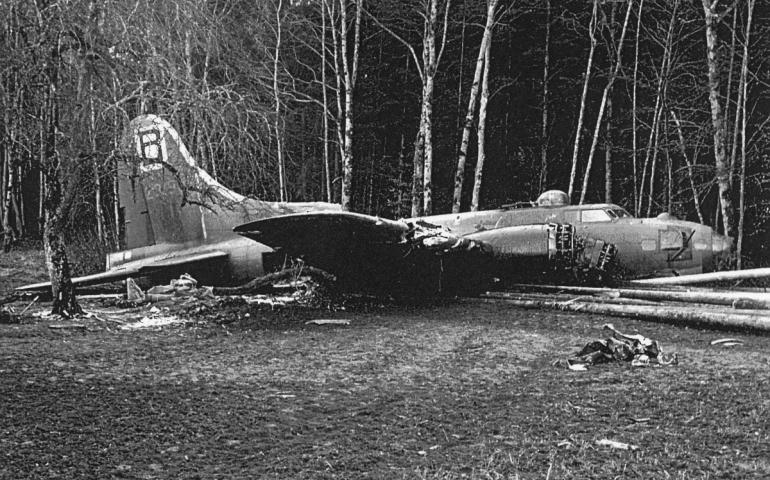
The story of two brothers, Ball Turret Gunner Sgt. George J. Hintz who parachuted out of a burning B-17G in Switzerland on February 25, 1945,and his brother 1st Lt. Loren Hintz who was shot down and killed in a P-47 Thunderbolt over Italy on April 21, 1945.
Ball Turret Gunner Sgt. George J. Hintz, February 25, 1945
The B-17G bomber of the 8th Air Force, 95th Bomb Group, 336th Squadron, Serial No. 42-31989 with the marking ET-M and the nickname "Black Magic" took off from Horham (GB) and had to emergency land in Ermensee, where it was scrapped, after a mission over Munich. Pilot 2Lt. Karel Havlik flew the B-17 and the ball turret gunner Sgt. George J. Hintz remembers this mission "We were about eight minutes from the target at an altitude of about 6'000 meters when our engine number four was hit by anti-aircraft fire and started to disintegrate. We quickly lost altitude and veered off towards Colmar (France). We were in the middle of heavy anti-aircraft fire, part of the nose was shot off and the wingtips were also shot to pieces. Tail Gunner Sgt. Wilbur I. Schraner had fired his ammunition when we received a direct hit to engine number three and had to shut it down immediately. The oxygen tanks were also hit and whistled like leaking car tires. It was when we had a big hole in the radio room that we prepared for an emergency landing. The radio tray had been hit, engine number two was on fire and the wings were also burning when the order to came to bail out. We all landed in the area of Schongau and Hämikon. The unmanned B-17 bomber continued to fly pilotless and flew over Richensee at low altitude, where it made a belly landing in Ermensee shortly thereafter, as if it had been landed by a pilot.
The B-17G with Serial No. 42-31989 had to make an emergency landing in Honington England on April 1, 1944. On May 19, 1944, the bomber returned to its group until it solo landed on its belly in Switzerland.
Crew:
Pilot: 1st Lt. Karel Havlik,
Copilot: 2nd Lt. Donald M. Johnston
Navigator: 2nd Lt. Lloyd L. Brandborg
Bombardier: Sgt. Robert H. Welsh
Engineer: T/Sgt. John Maruk
Radio: Sgt. Thomas R. Conry
Ball Turret: Sgt. George J. Hintz
Waist Gunner: Sgt. Charles H. Jones
Tail Gunner: Sgt. Wilbur I. Schraner
1st Lt. Loren Hintz, April 21, 1945
On the morning of April 21, 1945, there was a thick layer of low-lying mist near Bologna, Italy. Nevertheless, 1st Lt. Loren Hintz was able to see the green, haze-covered fields that resembled those belonging to his childhood farmhouse in Iowa. The war in Europe was coming to an end, which led to more pilots than missions. Many decided to stay behind and fly only if needed. But 26-year-old Loren was determined to go home. The more missions he completed, the sooner he could return to his one-year-old daughter Gretchen and his wife Gert, who was eight months pregnant. Little did Loren know that this one-hour mission "wheels up, wheels down" would be his last. That hazy morning, Hintz set off on his 66th mission of World War II. It was a formation of 12 planes carrying incendiary bombs with the aim of bombing German ground troops outside Bologna. Hintz was positioned at the rear of the formation, a "tail Charlie". This meant that the element of surprise had disappeared by the time Hintz descended to drop his bomb. The German troops began firing back, concentrating on Loren's plane. The P-47 Thunderbolt was hit and caught on fire, and within ten seconds the plane crashed into the same green fields that Loren had admired less than an hour earlier. 1st Lt. Loren E. Hintz of Charles City, Iowa, had made the ultimate sacrifice.
Source : Hans- Heiri Stapfer / AirCorps Aviation, Bemidji, MN
Reportage Black Magic